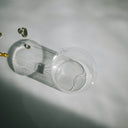Frontal baldness, commonly known as a receding hairline, is a concern for many individuals experiencing hair loss. As people seek effective solutions, one treatment that often comes up is minoxidil. This article delves into whether minoxidil works on frontal baldness, providing insights and information to help you understand its effectiveness.
Table of content
Does minoxidil work on frontal baldness?
Yes, minoxidil can be effective for treating frontal baldness, particularly in individuals with androgenetic alopecia (male or female pattern hair loss). Minoxidil is an FDA-approved topical treatment that promotes hair regrowth by stimulating hair follicles and increasing blood flow to the scalp. Clinical studies have shown that it can lead to noticeable improvements in hair density and thickness in the frontal area, but results may vary based on individual factors such as genetics and the extent of hair loss.
Minoxidil is available in various formulations, including liquid and foam, and is typically applied twice a day. For optimal results, consistency is key, and it may take several months to see significant changes. While many users report positive outcomes, it’s essential to understand that minoxidil does not work for everyone, and its effectiveness may diminish over time.
In addition to its application on frontal baldness, minoxidil is often combined with other hair restoration treatments, such as finasteride, to enhance results. Consulting with a healthcare provider can help determine the best approach for your specific situation. Overall, while minoxidil is not a guaranteed solution for frontal baldness, it offers a viable option for many seeking to reclaim their hairline.
As your leading source for hair health information over the past 4 years, we never compromise on accuracy. When it comes to your health, you deserve information you can truly rely on - and earning your trust is our top priority.
Here's how Scandinavian Biolabs ensures every piece of content meets the highest standards of accuracy and integrity:
- Credentialed Experts: Our reviewers are actively practicing doctors and medical researchers
- Stringent Reviews: Content undergoes rigorous editing by subject specialists and review by a practicing doctor.
- Evidence-Based: We rely on well-established research from trusted scientific sources like peer-reviewed journals and health authorities.
- Full Transparency: Our editorial standards, writer credentials, reviewer credentials, correction process, and funding are all publicly documented.
- Independent Voice: While we do promote products, we operate in a vacuum to business operations. Our main goal is just an unwavering commitment to providing medically-sound guidance.
You can count on Scandinavian Biolabs to consistently deliver the trustworthy health information you deserve. Read our Editorial Standards.
Understanding Minoxidil and Its Mechanism
Minoxidil was originally developed as an oral medication for high blood pressure. However, researchers discovered its side effect of promoting hair growth, leading to its formulation as a topical treatment for hair loss. The exact mechanism by which minoxidil stimulates hair growth is not fully understood, but it is believed to work by:
- Enhancing blood flow to hair follicles, providing them with essential nutrients and oxygen.
- Extending the anagen (growth) phase of the hair cycle, allowing hair to grow longer and thicker.
- Increasing the size of hair follicles, resulting in the production of thicker hair strands.
The Science Behind Minoxidil and Frontal Baldness
Several clinical studies support the use of minoxidil for androgenetic alopecia, with research indicating positive outcomes for frontal baldness. A study published in the Journal of the American Academy of Dermatology demonstrated that participants using minoxidil experienced significant hair regrowth compared to those using a placebo. Furthermore, the effects were more pronounced in individuals with less severe hair loss.
However, it’s important to note that results can vary widely among users. Factors such as age, genetics, and the duration of hair loss can influence the effectiveness of minoxidil. Younger individuals or those in the early stages of hair loss may respond better to treatment than those with advanced baldness.
Proper Use of Minoxidil for Best Results
To maximize the effectiveness of minoxidil in treating frontal baldness, adhere to the following guidelines:
- Apply Consistently: Use minoxidil as directed, typically twice daily, to maintain steady levels of the medication on the scalp.
- Follow Application Instructions: Ensure the scalp is clean and dry before application. Use the recommended amount, usually 1 mL for liquid formulations or a sufficient amount of foam.
- Be Patient: Hair regrowth takes time; it may take 4 to 6 months to see noticeable results, and improvement can continue up to a year.
- Do Not Overuse: Applying more than the recommended amount will not accelerate results and may increase the risk of side effects.
Potential Side Effects of Minoxidil
While minoxidil is generally safe for most users, it can cause side effects in some cases. Common side effects include:
- Scalp irritation or itching
- Dryness or flaking of the scalp
- Unwanted facial hair growth in women
- In rare cases, more serious side effects such as rapid heart rate or swelling can occur.
If you experience any severe side effects or if side effects persist, it is essential to consult with a healthcare provider immediately. They can help assess your situation and determine if minoxidil is the right treatment for you.
Alternative Treatments for Frontal Baldness
While minoxidil is a popular option for treating frontal baldness, other treatments may also be effective, including:
- Finasteride: An oral medication that inhibits the hormone dihydrotestosterone (DHT), which contributes to hair loss.
- Hair Transplant Surgery: A surgical procedure that involves relocating hair follicles from a donor site to the balding area.
- Low-Level Laser Therapy (LLLT): A non-invasive treatment that uses laser light to stimulate hair follicles.
- Platelet-Rich Plasma (PRP) Therapy: Involves injecting platelets from your blood into the scalp to promote healing and hair growth.
Conclusion
In summary, minoxidil can be an effective treatment for frontal baldness, especially for those with androgenetic alopecia. While results may vary, many users experience positive outcomes with consistent use. If you are considering minoxidil, it’s crucial to follow the application guidelines and consult with a healthcare professional to determine the best treatment plan for your needs. Whether you choose minoxidil or explore alternative options, proactive measures can help you address frontal baldness and achieve the results you desire.
Minoxidil Side Effects Got You Down? There's A Plant-Based, Drug-Free Option.
Minoxidil can be a double-edged sword for hair regrowth. It works, but often comes with scalp irritation and unwanted hair growth. Maybe you'd prefer a gentler approach altogether?
The good news is, effective alternatives exist. Many simply aren't aware of them.
Here's what you likely crave:
- Soothe the Scalp: Ditch the itch and irritation.
- See Real Results: Noticeable hair regrowth, not just less shedding.
- Safe for Everyday Use: A trusted product you can rely on.
Bio-Pilixin® to the Rescue
Bio-Pilixin® is a clinically tested, drug-free answer to your hair loss woes.
- Gentle Yet Effective: Powerful results without harsh chemicals.
- Help Reduce Shedding, Increase Growth: Studies show significant hair regrowth for users.
- Safe & Plant-powered Formula: Confidence you can use Bio-Pilixin® daily.
Bio-Pilixin® offers the powerful, yet gentle approach you've been searching for.
Read more:






